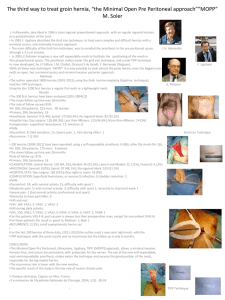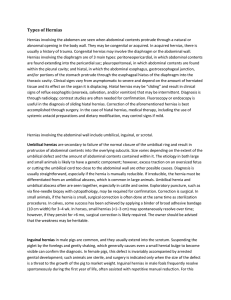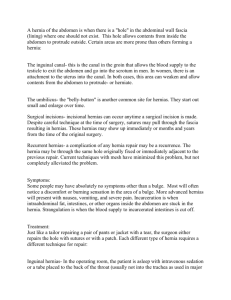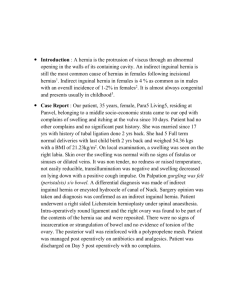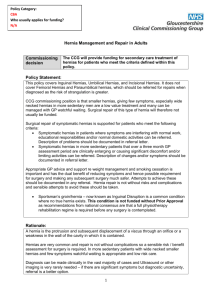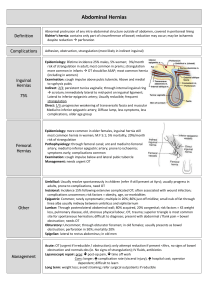Inguinal and Umbilical Hernias
advertisement
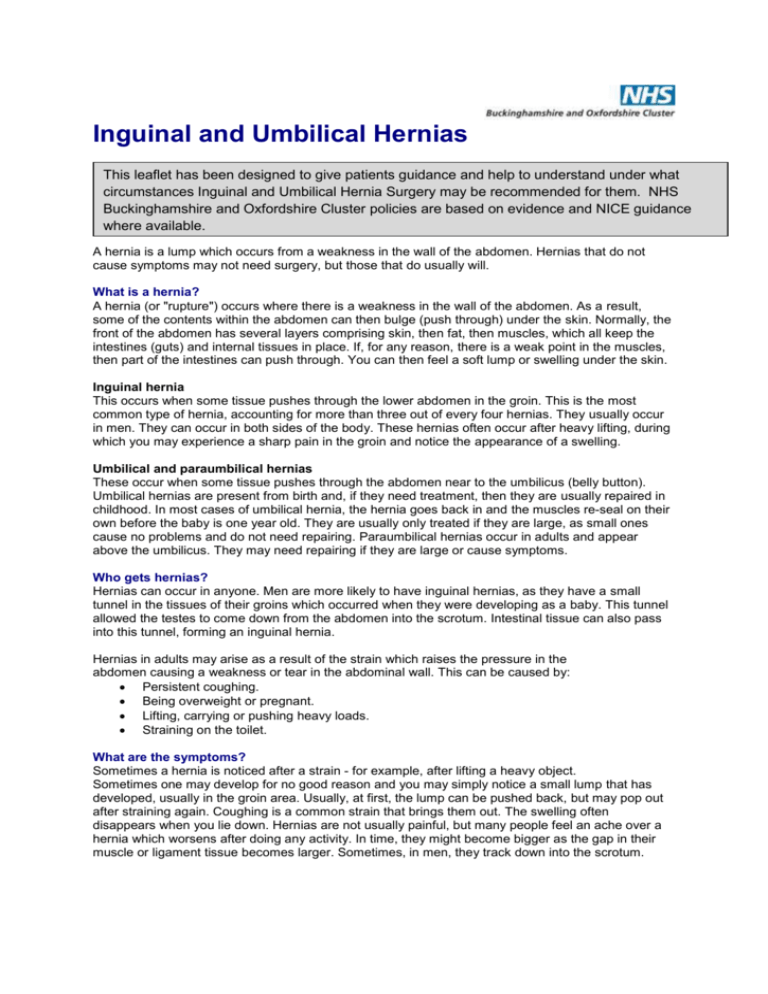
Inguinal and Umbilical Hernias This leaflet has been designed to give patients guidance and help to understand under what circumstances Inguinal and Umbilical Hernia Surgery may be recommended for them. NHS Buckinghamshire and Oxfordshire Cluster policies are based on evidence and NICE guidance where available. A hernia is a lump which occurs from a weakness in the wall of the abdomen. Hernias that do not cause symptoms may not need surgery, but those that do usually will. What is a hernia? A hernia (or "rupture") occurs where there is a weakness in the wall of the abdomen. As a result, some of the contents within the abdomen can then bulge (push through) under the skin. Normally, the front of the abdomen has several layers comprising skin, then fat, then muscles, which all keep the intestines (guts) and internal tissues in place. If, for any reason, there is a weak point in the muscles, then part of the intestines can push through. You can then feel a soft lump or swelling under the skin. Inguinal hernia This occurs when some tissue pushes through the lower abdomen in the groin. This is the most common type of hernia, accounting for more than three out of every four hernias. They usually occur in men. They can occur in both sides of the body. These hernias often occur after heavy lifting, during which you may experience a sharp pain in the groin and notice the appearance of a swelling. Umbilical and paraumbilical hernias These occur when some tissue pushes through the abdomen near to the umbilicus (belly button). Umbilical hernias are present from birth and, if they need treatment, then they are usually repaired in childhood. In most cases of umbilical hernia, the hernia goes back in and the muscles re-seal on their own before the baby is one year old. They are usually only treated if they are large, as small ones cause no problems and do not need repairing. Paraumbilical hernias occur in adults and appear above the umbilicus. They may need repairing if they are large or cause symptoms. Who gets hernias? Hernias can occur in anyone. Men are more likely to have inguinal hernias, as they have a small tunnel in the tissues of their groins which occurred when they were developing as a baby. This tunnel allowed the testes to come down from the abdomen into the scrotum. Intestinal tissue can also pass into this tunnel, forming an inguinal hernia. Hernias in adults may arise as a result of the strain which raises the pressure in the abdomen causing a weakness or tear in the abdominal wall. This can be caused by: Persistent coughing. Being overweight or pregnant. Lifting, carrying or pushing heavy loads. Straining on the toilet. What are the symptoms? Sometimes a hernia is noticed after a strain - for example, after lifting a heavy object. Sometimes one may develop for no good reason and you may simply notice a small lump that has developed, usually in the groin area. Usually, at first, the lump can be pushed back, but may pop out after straining again. Coughing is a common strain that brings them out. The swelling often disappears when you lie down. Hernias are not usually painful, but many people feel an ache over a hernia which worsens after doing any activity. In time, they might become bigger as the gap in their muscle or ligament tissue becomes larger. Sometimes, in men, they track down into the scrotum. When do they need treatment? Although having a hernia is not usually a serious condition, treatment to fix it is sometimes advised for two reasons: It may gradually become bigger and more uncomfortable. There is a small chance it might strangulate. A hernia strangulates when too much intestine (bowel) has come through the gap in the muscle or ligament and then it becomes squeezed. This can cut off the blood supply to the portion of intestine in the hernia. This can lead to severe pain and some damage to the part of the intestines in the hernia. A strangulated hernia is uncommon and is usually dealt with by emergency surgery. How are hernias repaired? A hernia can be fixed by a small operation. Wearing a truss (support) was used in the past but is now not recommended. It is very common for people to have their hernia repaired as a day case so you do not need to stay overnight in hospital. A hernia can either be repaired under a local or a general anaesthetic. This will depend on the actual type of repair operation needed, which will depend on the type of hernia, the size of the hernia and your general health. The operation is usually very successful. However, hernias can recur in a small number of people, when a further operation may be advised. It is most common that inguinal hernias be repaired by using a mesh. This is a thin sheet of material which is usually stitched or glued over the hole of the hernia. This has been shown to be stronger and more effective than sewing the edges of the hole together for inguinal hernias. With time, the mesh safely becomes incorporated into the muscle layer, which results in a very strong, permanent repair. Most umbilical hernias do not need repairing. Smaller hernias are usually repaired by an operation which simply closes the defect with stitches. However, umbilical and parumbilical hernias over 2 cm in length are usually repaired by using a mesh. Losing weight if you are overweight and stopping smoking if you are a smoker will be essential to the success of surgery. The full policy for this condition can be found at: http://www.buckinghamshire.nhs.uk/your-pct/individual-case-review-panel Further information about this condition may be found on the NHS Choices web sites: http://www.nhs.uk/conditions/Pages/BodyMap.aspx?Index=A For further assistance please contact: NHS Buckinghamshire PALS (Patient Advice & Liaison Service) on freephone 0800 328 5640 or email: Patientexperience.service@buckinghamshire.nhs.uk Adapted from EMIS PILS Leaflet 88 Comprehensive patient resources are available at www.patient.co.uk Disclaimer: This article is for information only and should not be used for the diagnosis or treatment of medical conditions. NHS Buckinghamshire has used all reasonable care in compiling the information but make no warranty as to its accuracy. Consult a doctor or other health care professional for diagnosis and treatment of medical conditions.


